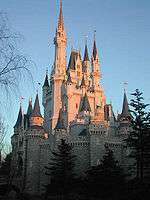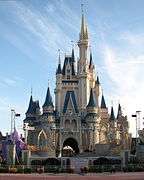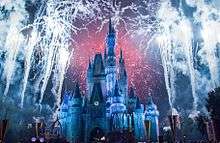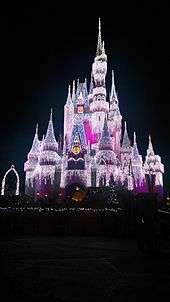Cinderella Castle
| Cinderella Castle | |
|---|---|
|
Cinderella Castle at Magic Kingdom | |
| Magic Kingdom | |
| Area | Fantasyland |
| Coordinates | 28°25′10″N 81°34′52″W / 28.4195°N 81.5812°W |
| Status | Complete |
| Opening date | October 1, 1971 |
| Tokyo Disneyland | |
| Area | Fantasyland |
| Coordinates | 48°52′24″N 2°46′34″E / 48.8732°N 2.776°E |
| Status | Complete |
| Opening date | April 15, 1983 |
| General statistics | |
| Manufacturer | Disney |
| Designer | Walt Disney Imagineering |
| Theme | Cinderella and Gothic Revival |
Cinderella Castle is the fairy tale castle at the center of two Disney theme parks: the Magic Kingdom at the Walt Disney World Resort, and Tokyo Disneyland at the Tokyo Disney Resort. Both serve as worldwide recognized icons and the flagship attraction for their respective theme parks.
Exterior
Inspiration and design


Cinderella Castle was inspired by a variety of real and fictional palaces. These included Fontainebleau, Versailles and the châteaux of Chenonceau, Pierrefonds, Chambord and Chaumont, as well as Castle Neuschwanstein, Bavaria, the Alcázar of Segovia in Spain and also the Moszna Castle in Poland which was built in the 18th century, in addition to the Tyn Church in Prague, Czech Republic, which was built in the 14th century. The chief designer of the castle, Herbert Ryman, also referenced the original design for the castle in the film Cinderella and his own well-known creation — the Sleeping Beauty Castle at Disneyland in California.[1]
Construction
Magic Kingdom
Cinderella Castle was completed in July 1971, after about 18 months of construction. The castle is 183 feet (56 m) tall, as measured from water-level. Many sources quote the height as six feet taller, but that is measured from the concrete bottom of the moat, which itself is 6 feet (1.8 m) deep at the bridge. Cinderella Castle is more than 100 feet (30 m) taller than Sleeping Beauty Castle at Disneyland in Anaheim, California. A set-building trick known as forced perspective makes the castle appear even larger than it actually is. At higher elevations, its proportions to full scale are reduced for elements such as stones, windows, and doors. The castle was the largest Disney theme park castle until the completion of the Enchanted Storybook Castle in Shanghai Disneyland Park.
Cinderella Castle is designed to reflect the late-Gothic, flamboyant style of the 1400s. Unlike Disneyland's castle, no gold is used on the exterior; all gold colors are anodized aluminum. Despite appearances, no bricks were used in its construction; the inner structure is constructed of six hundred tons of steel braced frame construction, and a 10-inch-thick (250 mm) reinforced concrete wall encircles the structure to the full height of the outermost stone-like walls. All of the steel and concrete works are supported on a concrete drilled caisson foundation. Much less fiberglass is used than is popularly supposed. Rather, most of the exterior is a thick, very hard fiber-reinforced gypsum plaster that is supported by light-gauge metal studs. Most fiberglass work is reserved for the exterior walls of more ornate upper towers. The roofs are not fiberglass, either. They are shingled in the same type of plastic that computer monitor shells are made from, attached to a cone of light gauge steel sheeting over the steel sub-frame. These towers were lifted by crane, then welded and bolted permanently to the main structure. Contrary to a popular legend, the castle cannot be taken apart or moved in any way in the event of a hurricane. It would take months to disassemble, it would be too dangerous to operate the 300-foot (91 m) crane required in windy conditions, and there would have to be a safer building to keep it in. As with every other building at Walt Disney World, it was simpler and safer to design it to handle a hurricane. It can easily withstand the 125 mph (175 km/h) design wind speeds in Central Florida with a great deal of strength in reserve.
Cinderella Castle is also surrounded by a moat, which contains approximately 3.37 million US gallons (12,800 m3) of water; however, unlike the drawbridge at Sleeping Beauty Castle in Disneyland, Cinderella Castle cannot raise its bridge. There are a total of 27 towers on the castle, each numbered 1-29—tower numbers 13 and 17 were deleted before construction when it was realized that they could not really be seen from anywhere in the park, due mainly to the other Fantasyland buildings. The tower with the clock in front is number 10, the tallest is number 20. Number 23 is the other golden-roofed tower.
Originally, a suite was planned for the Disney family and executives,[2] but since Walt Disney died nearly five years before the park opened, it remained unfinished, and eventually was turned successively into a telephone call center, a dressing room, and is currently a lavish Dream Suite hotel room for specially selected guests. There are three elevators inside the castle. One is for guest use and goes between the lobby of Cinderella's Royal Table, and the second floor where the restaurant is. The second is for restaurant staff use, and is located in tower 2 to the left of the drawbridge. It has landings in the Utilidors, the mezzanine level in a break room, and on the second floor in the kitchen. The third elevator is in tower 20, and services the Utilidors, the breezeway, the kitchen of Cinderella's Royal Table, and the Cinderella Castle Suite. The suite is about 30 feet (9.1 m) below the level where the cable is attached to tower 20. Access to the cable is by ladder. From January 2007 to December 2009 the suite was used as a prize for the Disney Dreams Giveaway at the Walt Disney World Resort during the Year of a Million Dreams celebration.
Cinderella Castle was designed so that it was tall enough that it could be seen from the Seven Seas Lagoon in front of the Magic Kingdom, where many guests took ferries from the parking lot to the gates of the park. In theme park jargon, Cinderella Castle was conceived as the primary "weenie" (a term commonly used by Walt and his Imagineers) that draws new entering guests through Main Street, U.S.A. towards the central hub, from where all other areas can be reached.
The Castle was repainted in the Fall of 2006, and now is a slightly off white, brown, and pinkish color, and the turrets are a much darker blue.
Tokyo Disneyland

It is generally considered to be a carbon copy of Magic Kingdom's castle, although the Tokyo version is 168 feet (51 m) tall.[3] However, from 1986–2006, a popular walk-through attraction called the "Cinderella Castle Mystery Tour" was featured within the castle. In June 2006, the castle was repainted to differentiate it from Cinderella Castle at Magic Kingdom. The castle now has gold trimmings, the rooftops have been painted a different shade of blue, and the white stone of the turrets now has a tan/dirty-pink color.
Special decorations
Cinderella Castle at the Magic Kingdom has been temporarily re-decorated on a few occasions.
- To commemorate the 25th anniversary of Walt Disney World Resort on October 1, 1996, Imagineers transformed the front of Cinderella Castle into an 18-story "birthday cake." Complete with red and pink "icing," giant candy canes and 26 glowing candles, the castle served as the centerpiece for the 15-month-long celebration. Designed by Walt Disney Entertainment Florida and later constructed by the Imagineers, this was no small undertaking. It took more than 400 US gallons (1,500 L) of pink paint to cover the castle, which was decorated with multicolored "sprinkles," 26 candles, ranging in height from 20–40 feet (6.1-12.2 m) tall, 16 two-foot (61 cm) long candy stars, 16 five-foot (1.5 m) candy bears, 12 five-foot (1.5 m) gumdrops, four six-foot (1.8 m) stacks of Life Savers, 30 three-foot (91 cm) lollipops, and 50 two-foot (61 cm) gumballs. Additionally, more than 1000 feet (305 m) of pink and blue inflatable "icing" was needed to finish it off. On January 31, 1998, the castle was transformed back to its original state.
- On Nov 16, 2004, the castle was modified to appear as though it was strewn with toilet paper, and Stitch is King was posted on a turret as faux graffiti to mark the grand opening of Stitch's Great Escape! that day. The material was removed after the park closed that evening.
- The castle's most recent redecoration commemorated the Happiest Celebration on Earth in honor of Disneyland's 50th anniversary and was formally unveiled on May 5, 2005. The castle's exterior was adorned with polished gold trim and accents, swags, banners and tapestries. Golden statues of Disney animated characters were also added to the exterior, including Peter Pan, Tinker Bell, and Wendy circling the tallest spire. Other statues included Kaa and King Louie from The Jungle Book, Simba, Timon, and Pumbaa from The Lion King, Sebastian and Flounder from The Little Mermaid, the Cheshire Cat and White Rabbit from Alice in Wonderland, and Victor, Hugo and Laverne from the Hunchback of Notre Dame. Just above the front archway sat an enormous "stained-glass" mirror modeled after the magic mirror in Snow White and the Seven Dwarfs. The mirror changed images every 40 seconds to feature each Disney castle and the date its park opened: Disneyland, 1955; the Magic Kingdom, 1971; Tokyo Disneyland, 1983; Disneyland Resort Paris, 1992; and Hong Kong Disneyland, 2005. The decorations were removed in late September 2006.
 For Walt Disney World's 25th anniversary celebration, c.1996
For Walt Disney World's 25th anniversary celebration, c.1996 For the Happiest Celebration on Earth
For the Happiest Celebration on Earth Cinderella Castle during Grad Nite
Cinderella Castle during Grad Nite
At night

When the sun sets, the castle is illuminated by SGM Palco LED lighting fixtures placed on different castle levels and surrounding areas, providing an effective range of 16.7 million colors. The castle itself plays a role in the Magic Kingdom's fireworks show, Wishes: A Magical Gathering of Disney Dreams, in which it changes color in synchronization with the dramatic music of the display. The same color changing and effects occurs for the other fireworks shows: HalloWishes (in Mickey's Not-So-Scary Halloween Party); Magic, Music and Mayhem (during Disney's Pirate and Princess Party); and the Christmas fireworks show Holiday Wishes during Mickey's Very Merry Christmas Party. The castle's projection mapping technology has been used in several night events, such as the Hocus Pocus Villain Spelltacular.

At the park's closing, the nightly 'Kiss Goodnight' is performed, in which Roy O. Disney's dedication speech for the Magic Kingdom is played all over the park alongside classic Disney music which changes with the vivid colors of the castle. Even when the park closes before 11pm (23:00), the show is performed a second time at 11pm (23:00), providing entertainment for guests of Disney resort hotels bordering the Seven Seas Lagoon. Beginning November 2007, for the first time, the "Castle Dream Lights", with over 200,000 LED Christmas lights[4] (as Disneyland Paris has since 2004), covered Cinderella's Castle and was lit nightly during a new stage show in front of the castle. The castle looks similar to ice and is very popular among guests during the holiday season, the only time it is now used.
The Magic, the Memories and You
| The Magic, the Memories and You | |
|---|---|
| Magic Kingdom | |
| Area | Cinderella Castle |
| Status | Closed |
| Opening date | January 18, 2011 |
| Closing date | September 3, 2012 |
| Replaced by | Celebrate The Magic |
| Disneyland | |
| Area | It's A Small World |
| Status | Closed |
| Opening date | January 18, 2011 |
| Closing date | September 3, 2012 |
| General statistics | |
| Attraction type | Multimedia and pyrotechnic show |
| Designer | Walt Disney Creative Entertainment |
| Theme |
Iconic moments from Disney films Disney Parks Memories |
| Music | Let the memories begin |
| Duration | 9-10 minutes |
|
| |
On January 18, 2011, a nighttime projection mapping show premiered at Cinderella Castle at Walt Disney World. The show featured photographs and videos of park guests, taken by Disney's PhotoPass employees, combined with projections of Disney characters and attractions and pre-selected music.[5] The Magic, the Memories and You show was presented before and after the nightly Wishes fireworks show, and was part of Disney's "Let the Memories Begin" campaign for 2011.[6] A parallel show existed at Disneyland, at the Disneyland Resort, taking place instead on the broad facade of It's a Small World. On September 3, this show ended its run and was replaced by a similar nighttime multimedia show, Celebrate the Magic, which debuted on November 13, 2012.
Interior
Mosaics
Inside the castle's archway, a series of five mosaic murals tells the story of Cinderella. Designed by Imagineer Dorothea Redmond and crafted and set in place by a team of six artists led by mosaicist Hanns-Joachim Scharff, the 15-by-10-foot (4.6 by 3.0 m) ornate panels are shaped in a Gothic arch. The murals took 22 months to complete and contain just over 300,000 pieces of Italian glass and rough smalti (glass made specifically for mosaics traditionally used by Italian craftsmen) in more than 500 colors. Many of the hand-cut tiles are fused with sterling silver and 14-karat (58 percent) gold, and some are as small as the head of a tack. Looking closely at these ornate murals, one will notice that each of Cinderella's wicked stepsisters appears with a little added color - one sister's face is clearly "red with anger", while the other is a little "green with envy" as they watch Cinderella try on the glass slipper.
Bibbidi Bobbidi Boutique
As of September 10, 2007, the castle is home to the "Bibbidi Bobbidi Boutique", first introduced at Downtown Disney. Inside, guests can receive a one-of-a-kind "princess transformation", which features a Disney Princess make-up, one of three hairstyles, a manicure, a sash, and/or a gown, crown, wand and shoes.
The King's Gallery, the former gift shop in this space, has moved to the Main Street Cinema on Main Street, U.S.A.
Cinderella Castle Suite
Inside the upper levels of Cinderella Castle, there is a suite that was intended to be an apartment for Walt Disney and his family when they were in Florida. After Walt died in 1966, the apartment was left unfinished. This space is not large, and can be compared to the size of a master bedroom and bathroom in an average house. The location of the suite can be identified from the outside by locating the stained glass windows with pictures in the center on the north and west sides of the castle, about 2/3 of the way up. The glass used contains many small, multi-faceted pieces, which slightly obscures the view of the park from inside the suite. The suite adjoins a sizable exterior balcony on the east side. The walls around this balcony are about 5 feet (1.5 m) high. This balcony affords views to the north, east, and south. The balcony is only accessible through an emergency exit and is not a guest area.
On June 7, 2005, it was announced by Disney that the suite would be completely decorated and upholstered as a 'royal bedchamber', which can sleep up to six people. It was available as a prize during the Year of a Million Dreams (2007) celebration taking place at all eleven Disney theme parks, and an overnight stay in the apartment was a prize randomly awarded to a guest at the four Walt Disney World theme parks and Downtown Disney.
Disney describes the apartment this way in their official press release:
Cinderella's Castle Suite is four stories above the surrounding Magic Kingdom -- a salon, bedchamber and bathroom off of a private marble-floored foyer, all replete with rich details:
Fluffy feather comforters beneath the regal canopy draping of two queen beds ... A cut-stone bedchamber floor inspired by the mosaic art masterpiece that adorns the castle's breezeway entrance to Fantasyland ... A parlor sofa that invites kicking off the shoes and curling up to read a chapter beneath the richly detailed vaulted ceiling of the salon ... Familiar castle-gray stone walls, rich hardwood paneling and ornate stained-glass windows.
In the foyer of the suite, guests will discover a design of the fairytale pumpkin coach in the marble floor inlay. A memorable artifact from the story, the famous glass slipper, adorns a cove. And through the doorway, the bedchamber and salon are appointed with furnishings in the style of the era of "the Louies," as Silvestri refers to the French rulers of the period inspiring the castle and Cinderella story. Nooks showcase clocks, porcelain and accessories befitting the period. Doors are richly detailed; the walls are covered with wood panels and wall coverings. In the bathroom, hand-decorated copper basins sit atop the vanity, recalling a time when fresh water was carried to the bedchamber.
Despite all the careful attention to centuries-old details, the amenities of the Cinderella's Castle Suite are definitely 21st century. There's a lavish garden tub plus a shower. There are also wheelchair accessible bathroom and bedroom facilities and elevator access to the suite. As for an ornately framed, 17th-century-style portrait of Cinderella above a regal fireplace in the bedchamber: it magically changes into a modern, 21st-century flat-screen HDTV. Also in the den there is a mirror, but can be turned on to reveal another flat-screen.
Cinderella's Royal Table
Cinderella's Royal Table, formerly known as King Stefan's Banquet Hall, is a restaurant inside the castle. Located on the second floor, guests can take the circular stairway or the elevator to the restaurant, where children are referred to as princes and princesses, while the adults in the party are referred to as lords and ladies. Walt Disney Imagineers had originally wanted to give the restaurant a regal name, and since there are no well-known characters from "Cinderella" that met their criteria, they instead took a little dramatic license and chose the name of Sleeping Beauty's father, King Stefan. The name was changed on April 28, 1997, in order not to confuse tourists. The restaurant is decorated not only with a number of stained glass windows and medieval objects, but with more than forty coats of arms. Each of these is an actual family seal, and represent some of the many people that played a major role in the design and construction of Walt Disney World, including Roger Broggie, Sr. (Imagineer and railroad aficionado who aided in the design of many attractions), Marc Davis (animator and theme park designer), Roy O. Disney (Walt's brother), John Hench (who designed the castle), Diane Disney Miller (Walt's daughter), Dick Nunis (former Chairman of Walt Disney Attractions), and Marty Sklar (Imagineering vice chairman and principal creative executive who worked alongside Walt Disney).
Cinderella's Royal Table is also the location of "Fairytale Dining at Cinderella's Royal Table." At breakfast, lunch and dinner Cinderella greets all guests in the castle foyer, and during the meal classic Disney princesses circulate among the tables.[7]
Cinderella's Fairy Tale Hall (Tokyo Disneyland)
Cinderella’s Fairy Tale Hall is located in the castle where Cinderella lives with Prince Charming. Cinderella, wanting to share her magical princess story, decided to open up the castle even during her absence and exhibit various artworks that show scenes from her story. At the lobby and corridor, guests will find eight murals showing how Cinderella changed from beloved daughter, to servant girl, and then to Princess. They will also see a diorama of Cinderella magically transformed into wearing a beautiful ball gown, and other artworks made from various materials such as paper, wood and glass. In the Grand Hall guests will find a magnificent chandelier, the renowned glass slipper, a throne, and special paintings that reveal a magical message when photographed using a flash.
Flight regulations (Walt Disney World)
By keeping the height of the castle's spire under 200 feet (61 m) tall, the castle at Walt Disney World was able to avoid Federal Aviation Administration (FAA) regulations that would require flashing aircraft warning lights at the top.[8] (The two taller attractions at Walt Disney World, The Twilight Zone Tower of Terror and Expedition Everest, top out at 199 feet to avoid this requirement as well.)
As a result of the September 11 attacks in 2001, amid concerns that general aviation could pose a threat to public safety, the FAA placed a permanent Temporary Flight Restriction (TFR) over the entire Walt Disney World Resort in Orlando, Florida. The flight restriction extends outward from an island near the Contemporary Resort (28°24′45″N 81°34′20″W / 28.41250°N 81.57222°W) at a radius of 3 nautical miles (5.6 km; 3.5 mi) up to 3,000 feet (910 m) above the ground level surface. Cinderella's Castle is used as a visual reference. Law enforcement and Walt Disney World Cessna 172 aircraft, however, are exempt from this TFR.[9]
See also
- Sleeping Beauty Castle
- Le Château de la Belle au Bois Dormant
- List of Magic Kingdom attractions
- List of Tokyo Disneyland attractions
References
- ↑ "Cinderella Castle | Walt Disney World Resort". Disneyworld.disney.go.com. Retrieved August 20, 2012.
- ↑ O'Keefe, Matt. "The Unique Histories of 6 Disney Icons". Themeparktourist.com. Retrieved 23 June 2016.
- ↑ Belloni, Matthew (June 22, 2016). "Bob Iger Interview – 'Star Wars' Reshoots, Political Plans & More". The Hollywood Reporter. Retrieved June 23, 2016.
- ↑ "Holiday 2014". Mickey Monitor: 6. 2014.
- ↑ "Disney World Announces New "Magic, Memories & You" Show". Retrieved April 26, 2011.
- ↑ "'The Magic, The Memories and You!' castle projection show starts Wednesday at Magic Kingdom". Retrieved April 26, 2011.
- ↑ https://disneyworld.disney.go.com/dining/magic-kingdom/cinderella-royal-table/
- ↑ "Aeronautical Information Manual, Section 2: Air Navigation and Obstruction Lighting". Federal Aviation Administration. January 8, 2015. Retrieved February 16, 2015.
- ↑ http://web.archive.org/web/20090215015552/http://tfr.faa.gov/save_pages/detail_9_4985.html
External links
| Wikimedia Commons has media related to Cinderella Castle at Magic Kingdom. |
- Castle Pictures from bigfloridacountry
- Cinderella Suite Pictures
- The Most Exclusive Hotel Room In The World: Inside Disney’s Castle
